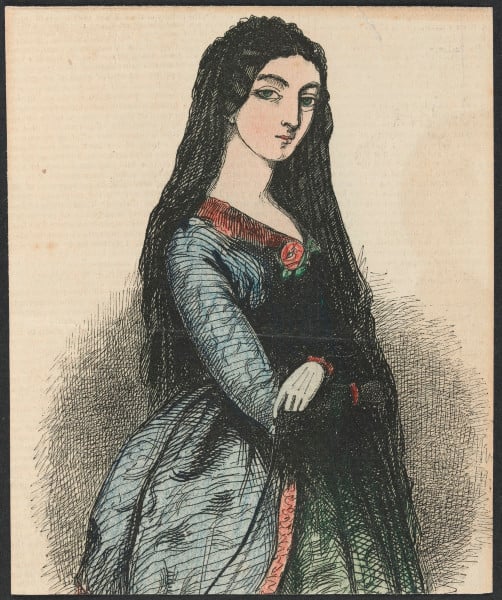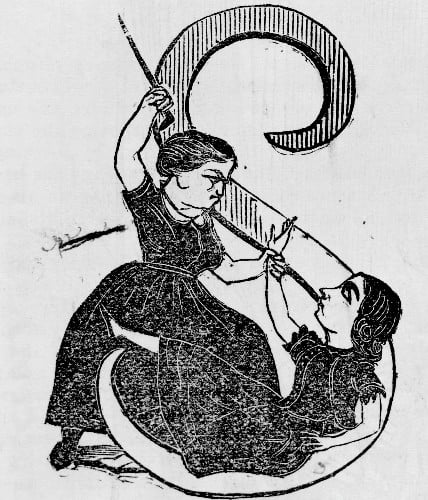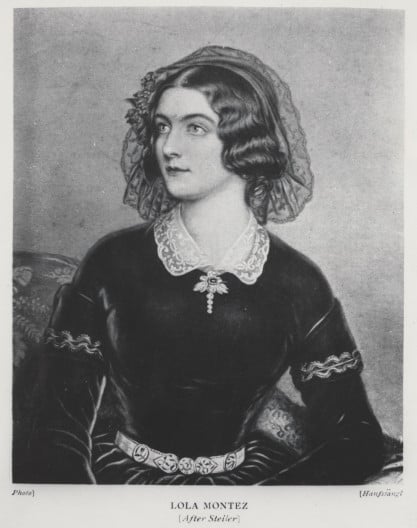
- A childhood spent in India and Britain
- Teenage elopement with an army officer
- Rumoured affairs with Hungarian composer Franz Liszt and French writer Alexandre Dumas
- Mistress to a king
- Riotous tour of the main cities and goldfields of Australia
No, this is not the outrageous plot for an upcoming Netflix series; just some of the highlights of the wild life of Lola Montez. 1
Lola was born in Ireland and christened Maria Dolores Eliza Rosanna Gilbert. Her father died when she was three and hers was a peripatetic childhood, spent in India, Scotland and England, at boarding schools and with relatives.
Her teenage elopement allowed her to escape an arranged marriage with a much older man, but it didn’t last and within a few years she was in Spain training to be a dancer.
Beautiful, vivacious and beguiling, she caught the eye of famous men, the most famous being King Ludwig I of Bavaria.
The besotted monarch honoured her as the Countess of Landsfeld, and allowed her much political influence as revolutionary zeal threatened Europe’s regal class. Rumoured infidelities reached the ear of the ageing king. In the midst of scandal he abdicated and Lola fled to Switzerland, with her Bavarian honours rescinded.
Following another brief and volatile marriage that led to bigamy charges and ended in ferocious arguement, she left the tumult of her European life for the theatres of New York. She took her dancing skills across America to San Francisco and beyond. In New Orleans Lola found herself the centre of several assault allegations.
First she was accused of striking her maid. Not one to accept such accusations quietly, when the police arrived she ‘resisted stoutly, even drawing a dagger and … employing her teeth.’ Escaping her captors, Lola dramatically seized a small vial labelled ‘poison’ which she swallowed, fainting to the ground. Perhaps the vial was mislabelled as she recovered quickly from her faint.2

Shortly after, a promoter at the New Orleans Varieties Theatre, Mr Rowe, claimed to have been kicked by Lola when he complained about her behaviour while another performer was on stage. At the hearing Lola asked witness Mr Placide, the theatre owner:
Didn’t you come behind the scenes in your shirt tail when I was playing your theatre, in a very immodest way, and you know Mr Placide, you are far from being a handsome man … 3
The complainant Rowe withdrew his charge, perhaps daunted by Lola’s forthright questioning.
Having scandalised Europe and then the United States, Lola arrived in Australia in August 1855. In February 1856 she was performing at the Victoria Theatre in Ballarat. The Ballarat Times described her as someone ‘who has no claim on our respect and whose notoriety is of an unenviable kind.’ 4
On Tuesday 19 February 1856, Lola won a riding whip in the Fancy Bazaar Lottery at the Star Concert Hall in Ballarat. Whip in hand she marched to the United State Hotel where the editor of the Ballarat Times, Henry Seekamp, was drinking at the bar. Incensed at the criticism in his newspaper, Lola struck him several times with her recently won whip.
According to a newspaper report blows were interspersed with questions:
“How dare you attack me in your paper?” “Will you abuse me again?” “Will you attack a woman ?” following up each inquiry by sundry sharp and cutting strokes from the switch, that soon imprinted certain facial notes of interrogation on her opponent. 5
Seekamp was not one to be cowed and took up his own riding whip. The two combatants then exchanged blows to the delight of bystanders.
Seekamp pushed his way out of the hotel. Once outside he was confronted by Frank Folland, an actor in Lola Montez’s show. The actor pulled out a revolver, but fortunately thought better of it. Seekamp, amid jeers of the gathering crowd, escaped to the Charles Napier Hotel.
To add insult to injury, Seekamp was then sued by Lola for libel. 6

Remarkably Lola was involved in a similar fracas shortly after when she ‘made use of some expression derogatory to Mr Crosby [her promoter] …with her characteristic boldness’ regarding her share of the theatre takings. Crosby’s wife
… immediately commenced striking Madame with a heavy whip, which she broke in the struggle, then seizing Madame by the hair, and beating her most unmercifully about the head and neck, so much so that it rendered Madame totally unable to appear on the stage according to public announcements. Any one knowing the calibre of Mrs Crosby, will easily understand how unequal the contest must have been, especially as the sole spectator was Mr Crosby … who would not call foul play, so long as his wife was what is called ‘getting the best of it’ 7

These incidents were the culmination of a tumultuous and controversial tour. In Melbourne, Lola had shocked the locals by performing her notorious spider dance at the Theatre Royal. The dance was based around the premise that she had a spider on her dress and had to lift the dress very high and shake the clothing vigorously to remove the spider. The Melbourne Argus described the performance as ‘utterly subversive of all ideas of public morality.’ (The Argus, 20 September 1855, p 5)
Dr Milton took his outrage a step further, demanding that:
… a warrant be issued against all repetition of the performances of Madame Lola Montes, at the Theatre Royal which [are] the extreme of indecency, and too disgraceful to be tolerated in a ‘civilised community.’ 8
Lola Montez sailed away from all the controversy without a backward glance, leaving Melbourne on 9 May 1856 for Sydney and then San Francisco. On the trip back, actor Frank Folland, another man bewitched by Lola’s allure, disappeared overboard.
Lola’s glory days were by then, behind her. She continued her stage career for a time, but her health was fading and her money was running out.9. Ever resourceful, she reinvented herself again, this time delivering lectures on topics such as ‘Female beauty’, ‘Gallantry’, and ‘Strong-minded women’. 10

When Lola died in New York in 1861, aged only 39, obituaries were both generous and mean-spirited. The New York Times celebrated her life:
… there are few readers … who are not familiar with the name of that eccentric, brilliant, impulsive woman, known as Lola Montez. As a danseuse, an actress, a politician, a courtesan, a lecturer, a devotee, she has occupied a large space in the public attention for many years … Her career, so strangely erratic, so wonderfully chequered, came to an end on Thursday last. 11
The Bombay Times addressed Lola’s death with prim and pompous rectitude.
The lesson is a sad one. We know that she was in her youth the plaything of foreign Courts: that she had a place in Cabinets; that she was the confidant of monarchs; that she received presents from nobles and judges; and that for years, she ran her course luxuriuosly and triumphantly, the Esmeralda of Dresden, the Cleopatra of Munich, the successful counter-intriguer against Prince Metterich … her bloom faded, extravagence had left her penniless, the mistress of the German Cophetus was reduced to lecture for a livelihood, to act in California theatres, to descend from one stage of degradation to another until she died upon a beggar’s pallet. 12
Whatever the response, few could claim to have lived such a vividly colourful life as Lola Montez.
Further resources
- Lola’s life, as reported in newspapers of the day, can be searched on both Trove and our international newspaper databases.
- We hold many books on Lola Montez
- In February 1958 the Australian musical Lola Montez, based on her time in Ballarat, premiered at Melbourne University’s Union Theatre. After some reworking it opened in Brisbane and then Sydney in October 1958. We hold the original soundtrack recording and scores for several songs. See also this article with images of a televised version of the musical
- The State Library of South Australia hold a series of sketches of Lola’s performances by John Skipper
References
- In Australian reports, Lola’s surname is often spelt Montes. Her exact birth date is not confirmed but probably either 1820 or 1821 although some sources list it as 1818.
- New York Daily Times, 21 February 1853, p 6
- ‘Lola Montez in New Orleans: her trial for assault and battery – scenes behind the scenes,’ New York Daily Times, 22 April 1853, p 8
- See ‘Lola Montes at Ballarat,’ The Age, 7 March 1856, p 3
- ‘Lola Montes at Ballaarat,’ Bendigo Advertiser, 1 March 1856 p 2
- Nothing came of her libel case as Lola didn’t travel to the Circuit Court in Geelong for the trial, however Seekamp was found guilty of a libel against her lawyer Edward Lewis and fined £100 in July 1856. Never one to step away from controversy, Henry Seekamp had been the only person jailed following the Eureka Stockade uprising of December 1854. His newspaper had been a great supporter of the miners and Seekamp was sentenced to six months for seditious libel. The sentence was reduced to three months after a monster petition was presented to Governor Hotham. He died in 1864.
- ‘Lola Montes at Ballarat,’ The Age, 7 March 1856, p 3
- The Argus, 24 September 1855, p 6
- Lola earned vast amounts of money during her career but managed to spend all of it on an extravagant lifestyle.
- See Montez, Lola, 1861, Lectures of Lola Montez (Countess of Landsfeld): including her autobiography. New York: Rudd & Carleton also available online.
- ‘Obituary: Death of Lola Montez,’ New York Times, 21 January 1861, p 8
- ‘A wasted life: Lola Montez,’ The Bombay Times and Standard, 11 April 1861, p 3. Prince Metterich had tried unsuccessfully to break Lola’s influence over Ludwig. ‘Cophetus’ refers to the legend of King Cophetua who fell in love with a lowly maid


I loved this blog! What a daring young woman, who lived an extraordinary life.
Great story!! A very good read…
Emily Eden in Up the Country: letter from India recorded the arrival of a Mrs. J “who has been talked of as a great beauty all the year” in Simla.
Sunday, Sept 8
“Mrs. J is the daughter of a Mrs C., who is still very handsome herself, and whose husband is deputy-adjutant-general, or some military authority of that kind. She sent this only child to be educated at home, and went home herself two years ago to see her. In the same ship was Mr. J, a poor ensign, going home on sick leave. Mrs. C. nursed him and took care of him, and took him to see her daughter, who was a girl of 15 at school. He told her he was engaged to be married, consulted her about his prospects, and in the meantime privately married this child at school. It was enough to provoke any mother, but as it now cannot be helped, we have all been trying to persuade her for the last year to make it up, as she frets dreadfully about her only child. She has withstood it till now, but at last consented to ask them for a month and they arrived three days ago. … J is a sort of smart-looking man, with bright waistcoats and bright teeth, with a showy horse, and he rode along in an attitude of respectful attention to “ma belle mere.”
Tuesday, Sept 10.
“We had a dinner yesterday. Mrs. J is undoubtedly very pretty, and such a merry unaffected girl. She is only seventeen now, and does not look so old, and when one thinks that she is married to a junior lieutenant in the Indian army, fifteen years older than herself, and that they have 160 rupees a month, and are to pass their whole lives in India, I do not wonder at Mrs. C’s resentment at her having run away from school.”
Sunday Nov 17
We left Kurnaul yesterday morning. Little Mrs. J. was so unhappy at our going, that we asked her to come and pass the day here, and brought her with us. She went from tent to tent and chattered all day, and visited her friend Mrs. ___, who is with the camp. I gave her a pink silk gown, and it was altogether a very happy day for her, evidently. It ended in her going back to Kurnaul on my elephant with E.N. by her side and Mr. J sitting behind, and she had never been on an elephant before, and thought it delightful. She is very pretty, and a good little thing, apparently, but they are very poor, and she is very young and lively, and if she falls into bad hands, she would soon laugh herself into foolish scrapes. At present the husband and wife are very fond of each other, but a girl who marries at fifteen hardly knows what she likes.”
Three points of note: the spider dance was scandalous because when she lifted her skirts, no underwear could be seen. She was supposed to be the model for the character of Irene Adler in the Arthur Conan Doyle story, ‘A scandal in Bohemia.’ She died of tertiary syphilis on 17 January 1861 in New York.
Her mother returned to live in England after being widowed again in India (29 September 1843) and died on 21 November 1875.
Thanks Chrissie for highlighting that great primary source. The letters can be read online at the Internet Archive and our Library also holds a print copy